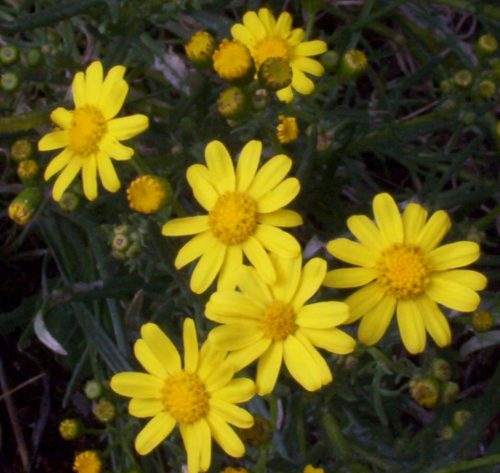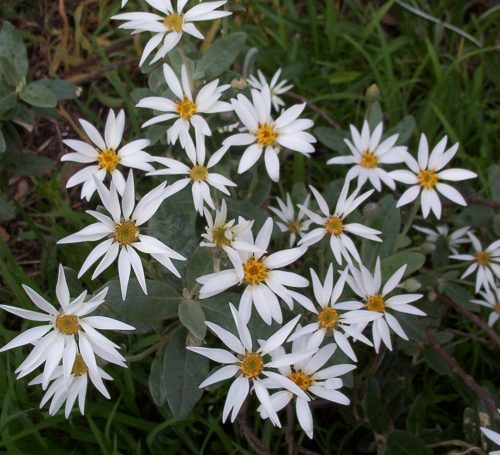Spring flowers: Senecio lautus, a native daisy

Native daisy Senecio lautus flowering in our small piece of scrub.
Why are you growing weeds? I was a bit taken a back because as far as I knew Senecio lautus was an Australian Native daisy. So what is a definition of a weed?
My understanding is that weeds:
- are introduced species from another continent, usually brought in by people knowingly or unknowingly eg. in the padding in saddles in the ‘olden days’.
- are introduced species which have become escapees from garden environments eg. watsonias and Acacia baileyana in the Adelaide Hills
- native species planted for a specific purpose which have escaped that particular environment
- native species which seed all over the place and take over garden beds. Some people don’t mind this but to others it is a nuisance and the plant is therefore a weed.
Senecio lautus may come into the latter category, but I don’t mind at all. Bring it on, I say. They flower among the mallee trees on our block, come up in pots where I don’t want them, flower prolifically along the South Eastern Freeway on the way to Adelaide and give a glorious glow of warmth on cold cloudy days.
They are easily pulled out if not wanted in a specific location. Some appear to be perennial up to 60-70cm tall, others flower at about 30cm, some require cutting back after flowering to maintain a neat bush. Many just appear to die back and re-shoot when it rains in early winter. I consider them worth having, but of course once you have one seed in the garden you are likely to have them next season whether you want them or not! Find out more about Senecio lautus.
I picked some yesterday morning in an experiment to see if they would last as a cut flower. I hadn’t bothered to try before. I will report back. One thing I did notice is that some flowers closed their petals last night.
Spring Flowering Plants

Olearia pannosa beginning to flower in my garden
When I look at the date on the last post made on this blog I am horrified but that is how life is sometimes. I have had to desist growing the large numbers of plants I used to but I cannot resist plants that have cuttings on them so I am always having a go at something, just not on the scale I would like to do.
A friend asked me for photos of a couple of South Australian native plants and that set me thinking about what I might be able to do on the blog. There are a number of posts that need tidying where links have been broken over the years, and probably better photos in my collection now. Spring is a great time to be stimulated to share the wonder of our amazing native plants as many begin to burst into flower in the next few months.
For further information Olearia pannosa.
What’s flowering in May?
There are quite a few plants flowering in my district in May. They include Swainsona formosa, Acacia iteaphylla, Eremophila maculata forms, to name a few. This has stimulated me to begin again on my blog, as well as the queries for information that I periodically receive. My lifestyle has changed and should allow me to pick up again.
Swainsona formosa may seem to be an unlikely plant to include in this list. However a roughly 5square metres front yard of a house in the town has been sown completely to the Sturt’s Desert Pea. The owner described to me that he threw a handful of seed over the yellow gravel he had spread over the area which may have been lawn before. He did it at this time of the year relying on natural rainfall to germinate the seed. He applied some extra water during the height of summer to keep them going. The result was a gorgeous display of red flowers with the black eye, against the grey green foliage. He showed me where more seed was germinating in some of the bare patches. He also had an abundance of seed pods filled with seed, a handful of which he generously gave to me.
Anigozanthos flavidus (Tall Kangaroo Paw)
I have just planted three of these plants. They were quite tight in their pots but were making new shoots so I decided to take a chance and put them in as they were. Mine are a yellow-green colour, but you can also get pink, orange, red, yellow or green, and sometimes mixed colours. The usual colour is the yellow -green
Two have gone onto a raised mound, and the third at ground level but with a dose of gypsum in case there is clay below the root ball. Mounds need only be 120 mm above ground level to achieve the drainage required.
This is the hardiest of the kangaroo paws and is used in breeding the new hybrids that are in many nurseries these days. I must say that I like the species plants even though I admire the new colours.
The strappy leaves on this plant can grow up to a metre tall and the clump to a metre across. However the flower spikes can grow to two metres . The seed I was given came from plants that had these very tall spikes and many flowers on the stalk.
It grows best in moist, light to medium soils, in partial to full sun, but will tolerate dappled shade. It can be damaged by frost.
Black ink disease is a problem in misty areas or locations where there is not enough air movement. Slugs and snails will cause a lot of damage.
Propagating Kurrajong and Grevillea
I had a pile of cutting material, mainly some pieces of Grevillea which I dealt with today. It is a bit cold now, but nothing ventured, nothing gained. I managed half a tray full of nice looking cuttings and went out to see what material was on Grevillea ‘Winpara Gem’ to fill up the space.
I walked past a small plant that I have had for years but had not had the heart to dig out. It has always been in the wrong spot so was mown, slashed and whipper snipped many times. It has 4 stems now. I realized a few weeks ago that it was a Kurrajong after I had read the article that prompted the post on Kurrajong.
The amazing thing about this plant is that it has always been a good dark green, and does not get water artificially and has survived many heavy frosts over the years. I have decided, belatedly, that it deserves some TLC so that I can get some more height in the plant. It will be a shrub shape rather than a tree now. I doubt that cutting 3 of the 4 branches out will help as it seems to induce more branching from the base of the plant. Anyway, to fill up the tray I cut one of the branches that was growing across the plant. I was able to take 6 nice pieces of tip growth as cuttings to see what will happen. I will put in some seed later also.
This plant is no longer in the wrong spot!
